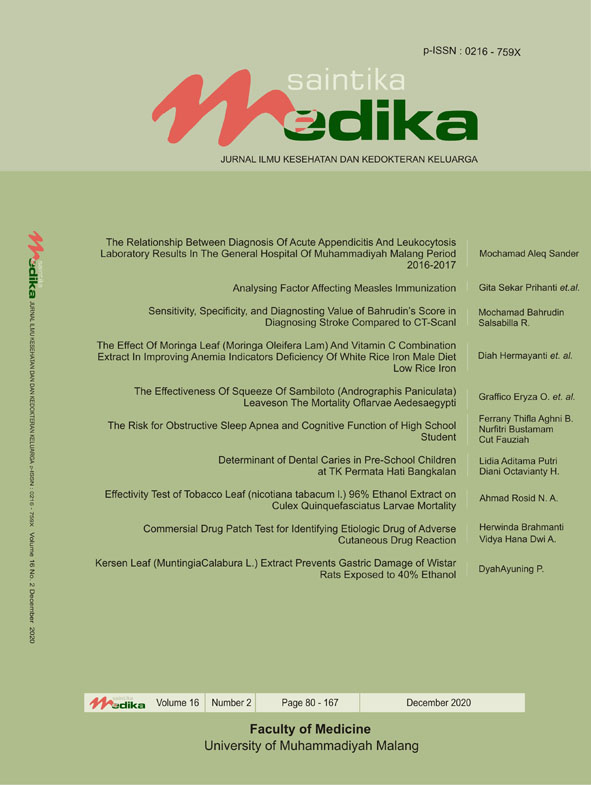Effectivity Test of Tobacco Leaf (nicotiana tabacum l.) 96% Ethanol Extract on Culex Quinquefasciatus Larvae Mortality
DOI:
https://doi.org/10.22219/sm.Vol16.SMUMM2.11403Keywords:
Tobacco leaf extract, Culex quinquefasciatus, Larvicide, FilariasisAbstract
Culex quinquefasciatus acts as a vector for Filariasis disease. The transmission of this disease can be prevented by cutting the life cycle of these mosquitoes at the larvae phase. Tobacco leaf contains an alkaloid, flavonoid, essential oil, saponin, and tannin which can kill Culex quinquefasciatus larvae. This study is a laboratory experiment with a post-test only controlled group design. This study used the larvae of Culex quinquefasciatus third-instar larvae. Six hundreds larvae were divided into 6 groups and 4 repetitions (each consisted of 25 larvae), i.e. negative control (distilled water + CMC), tobacco leaf ethanol extract (EEDT) with 0.025%; 0.05%; 0.075% and 0.1% doses and positive control (temephos). The number of dead larvae was counted at 6, 12, 18, and 24 hours after treatment. The results of the Kruskal-Wallis test showed p-value = 0.000, followed by the Mann-Whitney Post-hoc test, which resulted in all four doses of EEDT significantly differed compared to the negative control. However, 0.1% concentration was insignificantly different than the positive control. This showed that the ethanol extract of Nicotiana tabacum L. was effective in killing Culex quinquefasciatus larvae and EEDT with 0.1% concentration had the same potential as temephos as a larvicide.
Downloads
References
Ahdiyah, I. dan Purwani, K. I. 2015. "Pengaruh Ekstrak Daun Mangkokan (Nothopanax scutellarium) sebagai Larvasida Nyamuk Culex sp.". Jurnal Sains dan Seni ITS,Vol.4, No.2. Arimurti, A. 2018. Keanekaragaman Genetik Nyamuk Vektor Filariasis Culex Quinquefasciatus Say, 1823 (Diptera: Culicidae) di Kota dan Kabupaen Pekalongan Dengan Metode PCR-RAPD. The Journal Of Muhammadiyah Medical LAboratory Technologist, 1(2), pp. 42-61. Astriani, Y. dan Widawati, M. 2017. “Potensi Tanaman Di Indonesia Sebagai Larvasida Alami Untuk Aedes aegypti”, SPIRAKEL, Vol.8,No.2. Fajriani,N., Abdul, W., dan Adryani, R. 2019. “Ekstrak Daun Tembakau (Nicotiana tabacum L.) Sebagai Akarsida Pada Caplak (Boophilus microplus)”. E-.jurnal Politek Tegal, Vol.8,No.2. Fuadzy, H. dan Hendri, J. 2015. "Indeks Entomologi Dan Kerentanan Larva Aedes Aegypti Terhadap Temefos Di Kelurahan Karsamenak Kecamatan Kawalu Kota Tasikmalaya". Vektora : Jurnal Vektor dan Reservoir Penyakit,Vol.7, No.2. Handayani, S., Prastowo, D., Boesri, H., Oktsariyanti, A., dan Joharina, A,. 2018. "Efektivitas Ekstrak Daun Tembakau (Nicotiana tabacum L) dari Semarang, Temanggung, dan Kendal Sebagai Larvasida Aedes aegypti L". Balaba: Jurnal Litbang Pengendalian Penyakit Bersumber Binatang Banjarnegara, Vol.14, No.1. Khalalia, R. 2016. Uji Daya Bunuh Granul Ekstrak Limbah Tembakau (Nicotiana tabacum L) Terhadap Larva Aedes aegypti. Skripsi. Semarang: Universitas Negeri Semarang. Masrizal. 2018. "Penyakit Filariasis". Jurnal Kesehatan Masyarakat. Minarni, E., Armansyah, T., Hanafiah, A. 2013. Daya Larvasida Perasan Etil Asetat Daun Kemuning (Murraya paniculata (L) Jack) Terhadap Larva Nyamuk Aedes aegypti, Jurnal Medical Veterinaria, vol.7, no.1, hlm. 27–29. Otsuji, Y. 2016. "History, Epidemiology dan Control of Filariasis". Tropical medicine dan health. doi: 10.2149/tmh.39-1- 9876-1_25. Taufiq,S., Umi, Y., dan Siti, H. 2015. Uji Aktivitas Antibakteri Ekstrak Etanol Biji Buah Pepaya (Carica papaya L.) Terhadap Escheriachia coli dan Salmonella typhi.Prosiding Penelitian Spesia Unisba. ISSN 2460-6472suppl_2-3. Pan, J. 2015. "Filariasis". Radiology of Infectious Diseases. doi: 10.1007/978-94-017 Taylor, M. J., Achim, H., dan Moses, B. 2015. "Lymphatic filariasis dan onchocerciasis". The Lancet. doi: 10.1016/S0140-6736(10)60586-7. WHO. 2016. "Monitoring dan epidemiological assessment of mass drug administration in the Global Programme to Eliminate Lymphatic Filariasis. A manual for national elimination programmes". World Health Organization. Wijayanti,M P., Sri, Y., dan Retno, H. 2015.”Uji Toksisitas Ekstrak Daun Tembakau (Nicotiana tabacum) dengan Metode Maserasi Terhadap Mortalitas Larva Culex quinquefasciatus Say Di Laboratorium”. Jurnal Kesehatan Masyarakat,Vol 3,No.1. Yasmin, Y., Fitri, L. dan Bustam, B. M. 2012. “Analisis Efektifitas Tepung Jamur sebagai Larvasida Aedes aegypti”, Jurnal Natur Indonesia. ISSN 1410-937
Downloads
Published
Issue
Section
License
Authors who publish with this journal agree to the following terms:
- Authors retain copyright and grant the journal right of first publication with the work simultaneously licensed under a Creative Commons Attribution-ShareAlike 4.0 International License that allows others to share the work with an acknowledgment of the work's authorship and initial publication in this journal.
- Authors are able to enter into separate, additional contractual arrangements for the non-exclusive distribution of the journal's published version of the work (e.g., post it to an institutional repository or publish it in a book), with an acknowledgment of its initial publication in this journal.
- Authors are permitted and encouraged to post their work online (e.g., in institutional repositories or on their website) prior to and during the submission process, as it can lead to productive exchanges, as well as earlier and greater citation of published work (See The Effect of Open Access).

This work is licensed under a Creative Commons Attribution-ShareAlike 4.0 International License.
















